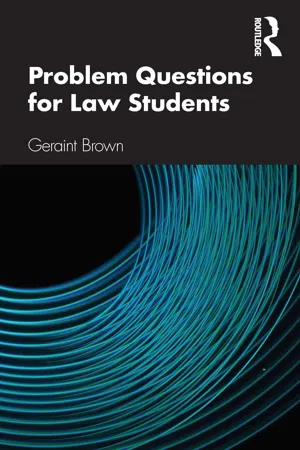
- 226 pages
- English
- ePUB (mobile friendly)
- Available on iOS & Android
About this book
Law students rarely have experience answering problem questions before university, and lecturers concentrate on teaching content rather than the exam skills needed. This book bridges the gap on how to transpose knowledge and research into structured and coherent answers to problem questions while earning a law degree.
Aimed at undergraduates, international students, and foundation and SQE candidates, the book gives a step-by-step study guide on how to navigate what a problem question is asking you to do. It deconstructs the process using examples from a range of different fields of law, providing essential guidance from research and critical thinking to style and tone.
Including a range of examples to test yourself against, this is an indispensable resource for any law student who wants to tackle problem questions with confidence.
Frequently asked questions
- Essential is ideal for learners and professionals who enjoy exploring a wide range of subjects. Access the Essential Library with 800,000+ trusted titles and best-sellers across business, personal growth, and the humanities. Includes unlimited reading time and Standard Read Aloud voice.
- Complete: Perfect for advanced learners and researchers needing full, unrestricted access. Unlock 1.4M+ books across hundreds of subjects, including academic and specialized titles. The Complete Plan also includes advanced features like Premium Read Aloud and Research Assistant.
Please note we cannot support devices running on iOS 13 and Android 7 or earlier. Learn more about using the app.
Information
PART B
Researching and writing
Part B aims
- Identify the legal problem within the question
- Organise main and sub-Claims
- Begin researching and note-taking
- Recognise legal authority and the power of each source
- Understand case law citation and abbreviation
- Perform searches and understand the returns
- Turn your research into an outline answer
- Find some seminal (key) cases dealing with contract law
- Use cases in your answer
- Make notes on your selected cases
- Create a plan for your answer
- Evaluate the pros and cons of each type of CLEO structure
- Identify the three basic structures of a problem question
- Understand which structure is the most suitable for your PQ
- And have an end of chapter test
Identifying Claims in a PQ

- Put a tick (√) next to points that you think are the most important which need a lot of detail.
- Which remaining points are minor (not as essential) but need less detail and exploration? Mark these with a plus (+).
- The previous two points are likely to be agreed (ie given) by both sides and presented in the PQ, however there may be facts which are disputed in your own assessed PQs. Mark these with a (Y, N or?) to show if the facts are agreed (yes), in disagreement (no), or if further research is required by yourself to discover this by using a question mark.
- Are there any hidden issues not directly written? Tutors will place hidden (or oblique) issues in a PQ to test the critical thinking of the students. Be careful you are not identifying a red herring (irrelevant claims).
- What can you infer (guess/assume) about what happened to the particular item mentioned in the PQ?
- What are the consequences of doing this? Is this a separate offence?
- How is this related to the question (who to advise)?
- Is it a major or a minor point?
- Therefore, should you write about this?

- “A private watch collector.” Not selling as a professional You’ll need to consider:
- Which facts are not in dispute?
- Which facts are disputed?
- Which facts may be contentious, deliberately unclear or incomplete?
- Which absent facts are needed to make a judgment on the preceding?
- Reading the facts of the PQ and it reminding you of a case
- Reading the PQ and recognising the legal area(s) within
- “A private watch collector.” Not selling as a professional
- “Specialist… watches website.” Check if this is still shown to ‘the public’
- “Pre-owned.” Not new, so less buyer protection for Peter?
- “Sees the post.” Not stated if the advert is an offer. How can it therefore be accepted to form a contract?
- “Online.” Is this different to seeing it in a shop, magazine?
- “Immediately emails/Next day, Peter revokes.” Explore the timing
- “Peter… emails Jack.” Delivery of communication (email) versus letter
- A £200 reduction is requested by Peter. How does this impact if it’s an offer and how it can be accepted (see point 4)?
- “Revoke.” Does the purpose impact any communication method?
- Method of communication (again) of withdrawal to home address
- Home v business address – which is the correct correspondence add...
Table of contents
- Cover
- Half Title
- Title Page
- Copyright Page
- Contents
- Preface
- How to use this book
- Acknowledgements
- Part A About problem questions
- Part B Researching and writing
- Part C Good academic practice
- Part D Resources
- Part E Answers
- Further reading
- Index